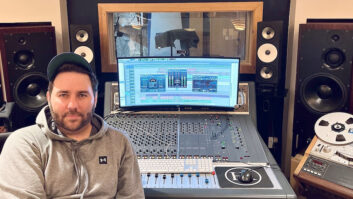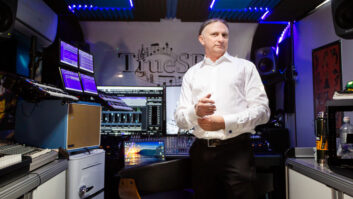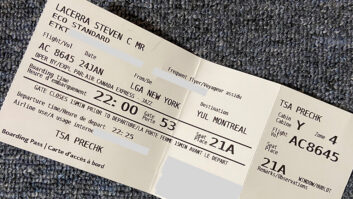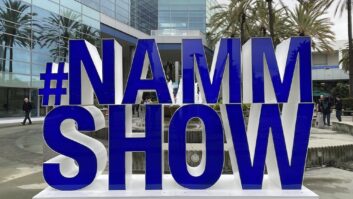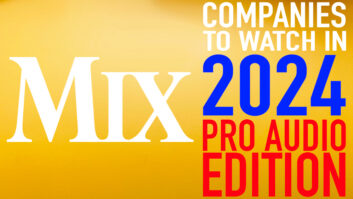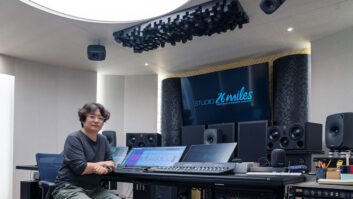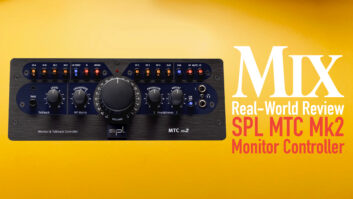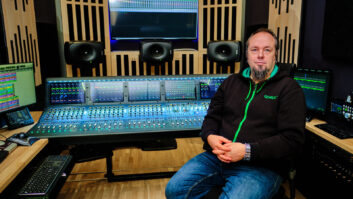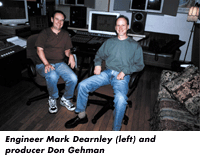
Anybody who’s spent time in a studio lately has observed whathappens when inexperienced producers collide with the endless choicesoffered by digital recording. Adrift in a sea of tracks and derailed bysystem crashes and mismanaged hard drives, sessions founder. Meanwhile,bored musicians wait, losing the edge that sparks a great track. Onproducer Don Gehman’s projects, you’ll find a different scenario.Applying a disciplined approach, he lays groundwork that frees him upto achieve what he’s really after: spontaneity and passionateperformances.
Gehman has had plenty of career success; he has produced numeroushit records, including multi-Platinum outings by John Mellencamp andHootie & The Blowfish. A few years ago, with an eye to the changingbusiness — and a better quality of life — he chose toreinvent his recording style. To that end, working with engineer MarkDearnley (AC/DC, Paul McCartney, Carl Perkins), he’s put together astreamlined record-making process that combines classic techniques withdigital speed.
“It was a conscious decision,” he explains, speakingfrom Sound Design Studios in Santa Barbara, Calif., where he isfinishing up sessions with Blues Traveler. “It actually cameabout from having my second child. If I were going to keep makingrecords, and also really be a dad, I had to figure out how to have moreflexible hours. Instead of working 12 hours straight every day, Iwanted the ability to put something up, work on it for three hours andput it away having accomplished something.”
Gehman met Dearnley, a computer expert and early Pro Tools convert,in 1999, and was impressed with his skill. The two set about designinga system that would enable total recall for an entire project. The endresult led to more than Gehman anticipated; he now finds himself makingrecords more efficiently, more economically and, he says, morecreatively.
To capture a performance’s special energy while a song is fresh,Gehman prefers to arrange songs in the studio rather than duringpre-production — something many producers, fearing chaos, avoid.Gehman often fills a studio with vast amounts of instruments andequipment during a session, all of it miked and ready. The setup isprecise and time-consuming, but then, “Engineering problems aresorted, we’ve got everything we need and can shift into creativemode.
“It’s good to rehearse a little so you get comfortable,”he comments, “but the magic happens early on; sometimes, beforeyou even realize it’s happening. It’s when you have to come back andget on track again that kills a lot of time. When we’re puttingtogether the arrangement and honing a groove, it’s all happening fast.If you’re recording all of that, you wind up doing a few takes thathave everything you need.
“The cut-and-paste part of today’s technology makes it easy tocomposite any take into the final production and still have a liveperformance,” he continues. “We can get one, or sometimesmore, full songs done in a day: a core track, vocals, backgrounds, someoverdubs and a rough mix. Every band we’ve worked with in the past yearhas been really excited by the process.”
Blues Traveler guitarist Chan Kinchla agrees. “As a musician,it’s a much more intuitive way to build songs,” he says.“When you’re in the creative moment, speed is good. You can onlystay focused for so long. Working this way, there’s no time to sitaround on the couch and sputter out.”
Of course, cut-and-paste production is routine these days. What setsGehman’s sessions apart is not only the amount of live materialrecorded, but the ability to access it quickly. That’s Dearnley’sdomain. He admits that it requires a lot of processing power, specialattention to file management, rigorous backup habits and a penchant forfast decision-making.
At the Blues Traveler mixdown, Dearnley was beta-testing DMODsoftware to upload high-quality, encrypted mixes to the Internet.“You can assign permission for a one-day time frame,” henotes. “Bandmembers get a full, uncompressed version to downloadand burn. If they want to send a portion to someone else, I can give it‘play-only’ permission so it can’t be burnt. The band canhear good-quality mixes and give us feedback without beinghere.”
“Mark and I have both been through the process of working withbands on albums that took over a year,” concludes Gehman.“We learned all of the things that you should never do. We knowthat our job is to cut to the quick with the songs. Now, with thesystems we’re using, we can make a project for half of the cost that weused to and get the same quality — maybe even better!”
